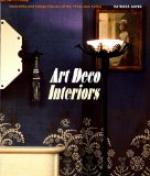In the same way lighting fixtures are links between the construction and decoration of a room, and can contribute to, or seriously divert from, the decorator’s design.
It is important that fixtures be so placed as to appear a part of the decoration and not merely to illuminate conveniently a corner of the room, a writing-desk, table or piano.
PLATE X
The dining-room of this
apartment is Italian Renaissance—oak,
almost black from age,
and carved.
The seat pads and lambrequin over window are of deep red velvet. The walls are stretched with dull red brocotello (a combination of silk and linen), very old and valuable. The chandelier is Italian carved wood, gilded.
Attention is called to the treatment of the windows. No curtains are used, instead, boxes are planted with ivy which is trained to climb the green lattice and helps to temper the light, while the window shades themselves are of a fascinating glazed linen, having a soft yellow background and design of fruit and vines in brilliant colours.
[Illustration: Dining-room Furniture, Italian Renaissance]
In planning your house after arranging for proper wall space for your various articles of furniture, keep in mind always that lights will be needed and must be at the same time conveniently placed and distinctly decorative.
One is astonished to see how often the actual balance of a room is upset by the careless placing of electric fixtures. Therefore keep in mind when deciding upon the lighting of a room the following points: first, fixtures must follow in line style of architecture and furniture; second, the position of fixtures on walls must carry out the architect’s scheme of proportion, line and balance; third, the material used in fixtures—brass, gilded wood, glass or wrought iron—must contribute to the decorator’s scheme of line and colour; fourth, as a contribution to colour scheme the fixtures must be in harmony with the colour of the side walls, so as not to cut them up, and the shade should be a light note of colour, not one of the dark notes when illuminated.
This brings us to the question of shades. The selecting of shapes and colours for shading the lights in your rooms is of the greatest importance, for the shades are one of the harmonics for striking important colour notes, and their value must be equal by day and by night; that is, equally great, even if different. Some shades, beautiful and decorative by daylight, when illuminated, lose their colour and become meaningless blots in a room. We have in mind a large silk lamp shade of faded sage green, mauve, faun and a dull blue, the same combination appearing in the fringe—a combination not only beautiful, but harmonising perfectly with the old Gothic tapestry on the nearby wall. Nothing could be more decorative in this particular room during the day than the shade described; but were it not for the shell-pink lining, gleaming through the silk of the shade when lighted, it would have no decorative value at all at night.




